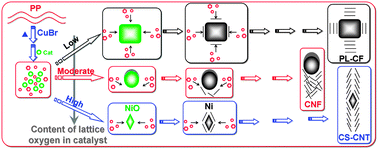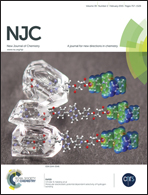New insights into the role of lattice oxygen in the catalytic carbonization of polypropylene into high value-added carbon nanomaterials†
Abstract
Catalytic conversion of waste plastics into high value-added carbon nanomaterials (CNMs) has attracted increasing attention; however, the role of lattice oxygen in the carbonization of plastics still remains ambiguous. In this work, firstly, a nickel catalyst with different content of lattice oxygen was prepared by the sol–gel combustion synthesis method. Subsequently, the effect of lattice oxygen in the nickel catalyst on the catalytic carbonization of polypropylene (PP, an example of plastics) into CNMs was investigated. It was found that the yield of CNMs increased dramatically with the increasing content of lattice oxygen. Large and short platelet-like carbon fibers were obtained when the content of lattice oxygen was low. With the increasing content of lattice oxygen, small, winding and short carbon nanofibers were produced. When the content of lattice oxygen further increased, long, small and straight cup-stacked carbon nanotubes were formed. Besides, it was demonstrated that lattice oxygen not only prevented the coalescence of nickel catalyst nanoparticles into large particles and promoted their reconstruction into rhombic shape, but also facilitated the catalytic carbonization of PP degradation products. This work provides new insights into the carbonization mechanism of plastics and puts forward a novel chemical method to prepare CNMs with diverse morphologies by controlling the content of lattice oxygen in the catalyst.


 Please wait while we load your content...
Please wait while we load your content...